In 2016 to celebrate the Ad Club of New York’s 120th anniversary, they invited readers to share their favorite marketing moments. Many cited Oreo’s ‘You Can Still Dunk In The Dark’ tweet from Super Bowl XLVII as their favorite marketing moment. Oreo only took about 10 minutes to publish it’s tweet after a power outage occurred at the Superdome. Have you ever wondered how the brand was able to respond at such short notice? Before we answer that question, do you think your current marketing team structure helps you to be agile or react to situations faster?
The truth is that most organizations today follow a traditional marketing team structure that doesn’t allow them to respond to the situations quicker. 360i, the agency behind Oreo’s campaign had a 15-member social media team ready to respond to whatever happened at SuperBowl – whether it was a mind-blowing play or half the lights shutting off.
How is the marketing team structure evolving?
Organizations have to drive agility as well as integration when it comes to defining their marketing team structure. The need for integration also arises from the obligation to eliminate data silos. Marketers also considering in-housing to reduce costs and to increase efficiency. Brands of all sizes, whether large or small, have in-house agencies now. HP, Spotify, Swiggy, Pepsi are all among the growing list of brands that have in-house studios now.
At a very rudimentary level, three models define every marketing team structure – in-housing, agency or hybrid model. In-housing became a norm as brands realize that a single agency on record, no matter how large didn’t have all the capabilities that a brand required. The hybrid model balances both in-housing and agency model by providing room to rope in experts from outside when needed.
As your brand grows in size, the need for centralization becomes more apparent. It puts in place better controls, ensures brand alignment, consistency and creates greater efficiencies. In contrast, a decentralized model offers higher flexibility at the lower end of the pyramid when it comes to differentiating the brand locally.
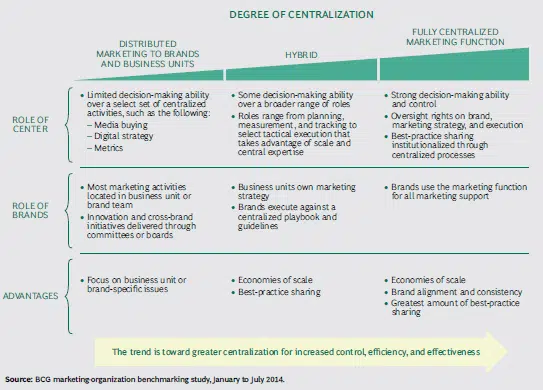
What are some of the common types of marketing structures
The traditional marketing team structure is evolving as the role of the marketing department evolves. Most notably, the CMO’s role is broadening to include additional responsibilities of technology and data. They also have shared responsibilities when it comes to areas like customer experience, product experience, market research to mention a few.
The way you structure your marketing team is primarily driven by your business goals and around your existing organizational structure.
Function-Centric Marketing Org Structure
This structure organizes the marketing function according to the distinct functions such as acquisition, customer marketing, brand marketing, digital and customer insights. This structure is common in companies that are fully centralized under a CMO and have one brand or product and clearly defined roles and required specialities.
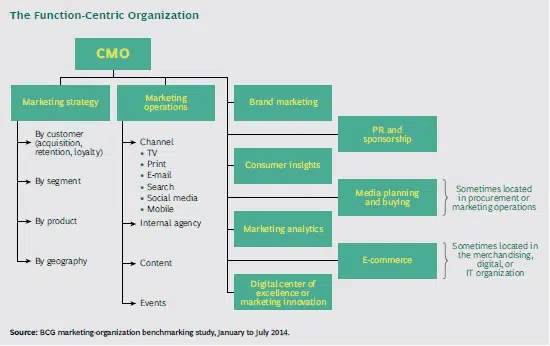
Product-Centric Marketing Org Structure
This structure is organized around products, or product lines, with different customer needs which are addressed through product variation. This structure is commonly used in consumer goods organization.
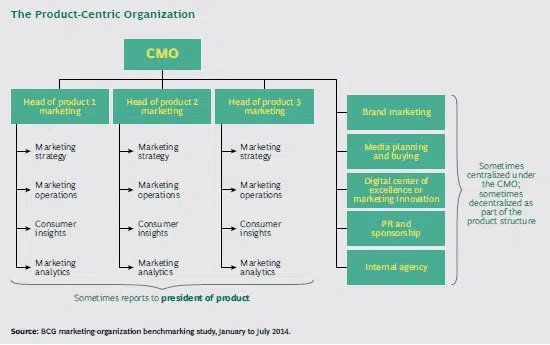
Channel-Centric Marketing Org Structure
This structure organizes the marketing function around the channels through which consumers purchase or experience the brand, such as wholesale, retail, in-store, online and catalogue. It is most common among retailers and brands with an e-commerce component.
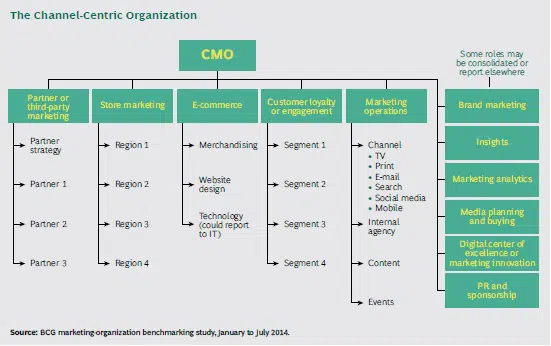
Geography Centric Marketing Org Structure
This structure organizes the marketing team basis local or regional geographies. This structure is common to global and multinational companies.
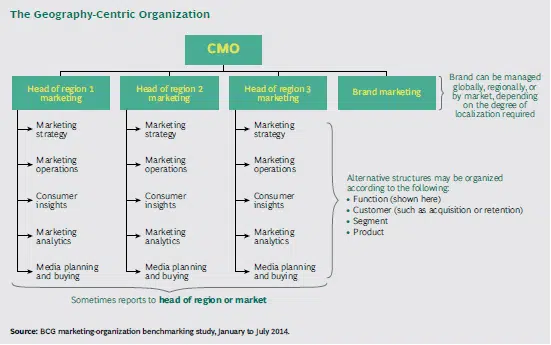
Segment-Centric Marketing Org Structure
This structure organizes marketing function basis customer-segments, each with distinctly different needs and channel mix strategies. You will find this structure commonly used in financial services, technology, and business-to-business organizations.
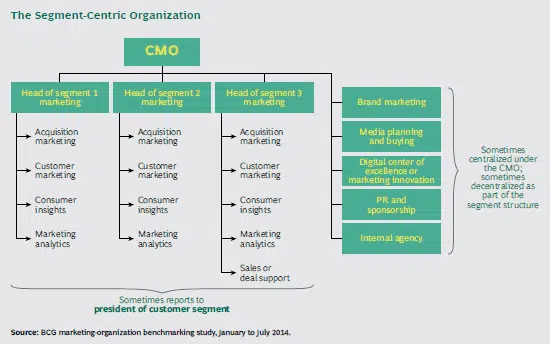
Future-proofing your marketing organization
Focus on Innovation
As you define your marketing structure also make sure you place focus on innovation. Best-in-class organizations are launching innovation labs to stay on top of trends and experiments. The structure shouldn’t become a barrier when it comes to innovation as most often processes also result in status-quo.
Driving Agility
Part of future-proofing your marketing function is to ensure that you can react to situations faster. It doesn’t matter whether it’s a message on social media or a public relations crisis. As you define your marketing structure, make sure you don’t create a lot of interdependencies to cut down on the bureaucracy.
Preparing for future skills
The new role created for functions like data science, artificial intelligence, user experience didn’t exist a few decades ago. Being ahead of the curve also means that you constantly identify new avenues that could potentially add value to the marketing team structure.
